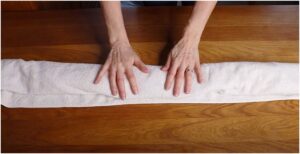
I still remember the day a latte leapt out of my hand and onto a blush satin skirt five minutes before a workshop.
I froze, the skirt glared back, and my brain whispered, how to clean satin without turning it into a crinkly mess? I hustled to the sink, worked my quiet magic, and taught class like nothing happened.
That little crisis became a ritual I now teach at Sew Mei Mei. Satin looks high-maintenance, but with the right touch, it’s totally manageable.
Consider this your friendly, step-by-step plan—equal parts craftswoman calm and practical TLC.
What exactly is satin—and why does it act so dramatic?
Satin isn’t a fiber; it’s a weave. That glossy face and matte back come from how the threads are floated, which also makes snags and water marks more likely.
You’ll find satin made from silk, polyester, rayon, or blends. The care is similar, but silk prefers extra-gentle handling, while polyester tolerates a bit more fuss.
Because the surface is sleek, residue loves to sit on top. That’s why harsh rubbing leaves dull patches and why hot water can distort the weave. Think “spa day,” not “boot camp,” and you’ll be fine.
How to Clean Satin at home without ruining the shine?

Image source- Marie-Anne Lecoeur – The French Chic Expert
Start with the care label.
If it says “dry clean only,” honor that—especially for structured gowns, interlined pieces, or garments with tricky trims. If hand washing is allowed, you’re in the sweet spot. Hand washing keeps the sheen intact and prevents the friction that machines can cause.
Your three ground rules: cool to lukewarm water (no hotter than 77°F/25°C), a mild detergent for delicates, and gentle touch.
Skip bleach, enzyme-heavy cleaners, fabric softener, and anything “brightening.” Satin loves low drama.
How to Clean Satin: the step-by-step I teach at Sew Mei Mei

1. Prep the bath.

Fill a clean basin with cool to lukewarm water. Add a small squeeze of delicate-safe detergent and swish until it disperses.
2. Turn it inside out.

Protect the glossy face by flipping the garment. If there’s a closure or trim, secure it so it doesn’t snag.
3. Soak, don’t stew.

Submerge for 3–5 minutes. Gently agitate with your hands. No scrubbing, wringing, or twisting—the weave will thank you.
4. Rinse clear.

Drain, then rinse under cool running water until it runs soap-free. Lift the garment from the water rather than dragging it.
5. The “sushi roll.”

Lay the piece flat on a clean towel. Roll it up like a maki roll to press out water—no squeezing.
6. Air-dry right.

Unroll and lay flat on a dry towel or hang on a padded hanger. Keep it away from direct sun and heat sources. Patience keeps the sheen.
7. Final smooth-out.
If wrinkles linger, steam lightly from the wrong side or press on the lowest setting with a pressing cloth. Quick taps, no lingering.
That’s the whole spa day. Quiet, controlled, and effective.
How to Clean Satin when there’s a stain involved?

Act fast. Blot (don’t rub) with a clean, damp cloth to lift what you can.
1. For water-based spots, mix equal parts cool water and white vinegar or lemon juice. Dab the solution onto the stain with a cloth, then blot with plain water to rinse. Always spot test in a hidden area first.
2. Oil and grease need a different move. Sprinkle cornstarch, baking soda, or talc directly onto the stain. Cover with a cloth, set a light book on top, and let it sit overnight. Brush away the powder in the morning and reassess. Repeat if needed before washing.
Important: never iron or steam over a stain—it sets it. Get the mark out first, then deal with wrinkles. Your future self will cheer.
How to Clean Satin in the washing machine—Is it ever okay?
Sometimes. If—and only if—the care label says machine washing is fine, give the fabric a fighting chance.
1. Turn the garment inside out, tuck it into a mesh laundry bag, and run a gentle/delicate cycle with cold water.
2. Use a small amount of delicates detergent and avoid overcrowding the drum.
3. Skip the dryer. Even if the tag allows tumble drying, air drying preserves drape and glow.
4. If you must use a machine, choose the lowest heat or air-fluff, keep it in the mesh bag, and remove while slightly damp to finish drying flat. But honestly? Air drying is the satin love language.
Do drying, ironing, and storage really make a difference?
Absolutely. Drying decides how your piece will drape tomorrow.
Flat-drying or padded hangers prevent shoulder bumps and seam stress. Keep satin away from radiators, sunny windows, and heat vents—sunlight can fade and weaken fibers.
Ironing should be a whisper, not a monologue. Use the silk/delicates setting, turn the piece inside out, and place a clean cotton pressing cloth between the iron and the fabric.
Quick, light passes are safer than slow, hot presses. Steaming is even kinder—hold the steamer a few inches away and let gravity help.
For storage, think “breathable and cushioned.” Clean and fully dry the garment first, then hang on a padded hanger or fold with tissue. Use breathable garment bags or saree bags. Plastic traps moisture; satin prefers to breathe.
FAQ: How to Clean Satin—real questions, real fixes
1. Can I use regular detergent to learn How to Clean Satin at home?
I wouldn’t. Regular detergents can be too alkaline or enzyme-rich, which dulls the sheen and roughs up the weave. Go for a pH-neutral delicates formula (or a silk-specific wash for silk satin).
You’ll use less, protect the finish, and avoid residue that leaves cloudy patches. If you’re sensitive to fragrance, pick an unscented version—satin can hold onto strong scents.
2. What if the label says “dry clean only,” but I still want to know How to Clean Satin myself?
That tag usually means there’s structure, interlining, or trim that won’t love water. If it’s a simple, unstructured polyester satin scarf or cami, you might hand wash carefully—but understand you’re taking a risk.
For silk gowns, jackets, or anything with boning, beads, or contrast piping, professional cleaning is worth it. When in doubt, test a tiny hidden corner first.
3. How to Clean Satin sheets or pillowcases without losing the glide?
Treat them like you would a delicate blouse, just with more water. Use cold water, a short gentle cycle, and a mesh bag if your machine tends to snag. Keep the detergent light and skip fabric softener—it can leave a film.
Air dry flat over a drying rack or make your bed while they’re slightly damp to smooth wrinkles. A quick steam once they’re dry brings the gloss back.
4. Is vinegar safe when I’m figuring out How to Clean Satin stains?
Used correctly, yes. A 1:1 mix of cool water and white vinegar can lift water-based stains, but always spot test first and dab—don’t flood or scrub.
Rinse the area with plain water after treating so you don’t leave a dull ring. For oil stains, skip vinegar and go straight to absorbent powders like cornstarch or talc.
Satin, but make it easy: your How to Clean Satin glow-up
You don’t need a dry-cleaning degree—just calm hands, cool water, and smart steps.
How to Clean Satin is really about protecting the weave, respecting the care label, and letting patience do the heavy lifting. Once you’ve walked through the process a couple of times, it becomes second nature.
My last workshop tip: create a small “satin kit”—delicates detergent, a clean white cloth, cornstarch, a mesh laundry bag, and a pressing cloth.
Keep it handy, and satin stops feeling like a diva and starts feeling like a favorite. If you try this tonight and need a pep talk, I’m cheering you on from Sew Mei Mei—with a firmly covered latte.



